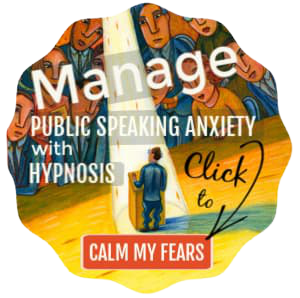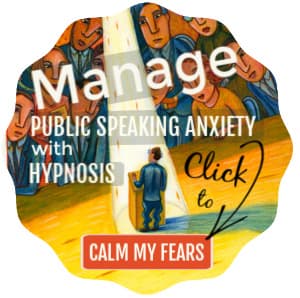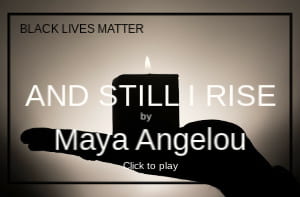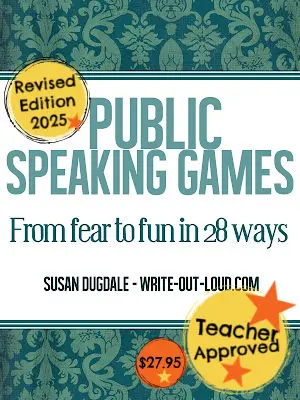- HOME ›
- Anxiety help ›
- Breathing exercises
Breathing exercises for public speaking
Breathe well to lessen anxiety, build confidence and improve voice quality
By: Susan Dugdale
Did you know regularly doing breathing exercises will help you become a better public speaker in two important ways?
Good breathing will lower your stress levels, help you let go of public speaking anxiety AND enhance your speaking voice.
You gain confidence plus a significantly more attractive and stronger voice. Yes, it's definitely a win-win.☺
What's on this page:
- what happens when we're anxious - the physiological effects
- the vicious circle of fear and its impact on our emotions
- two simple, very effective breathing exercises with multiple variations
- links to more resources to help manage public speaking anxiety
What anxiety does to us - its impact
Anxiety makes us 'up-tight' in more ways than one.
If you're familiar with the expression you'll know it generally applies to 'being snappy' or 'short tempered'.
Being up-tight is not only the temporary absence of our usually relaxed easy-going selves. It is also what literally happens physically.
Under stress we tighten our muscles and HOLD the tension we're feeling.
It locks itself into our bodies. The cumulative effect of long term unreleased tension can be varying forms of debilitating and often serious illnesses.
One of the first places tension shows is in our breathing patterns.
Anxiety makes us breathe more quickly and less deeply.
The result is the body perceives itself as being under threat and the automatic primitive survival mechanism fight or flight response takes over.

The physiological effects of anxiety include:
- breathing off the tops of our lungs which in turn gives rise to:
- less oxygen circulating in our system,
- a buildup of carbon monoxide (because it's not being released through full exhaling),
- and in some people, panic attacks and/or hyperventilation.
Consequences of becoming anxious on your voice
The direct consequence of anxiety on the quality of your voice is losing control of volume, pitch and tone.
Shallow breathing means you restrict the fullness of sound and range your voice might have.
It will sound small, higher, squeezed or strained because you are talking off the top of your lungs with a tight throat, jaw, mouth and face, which makes it significantly less attractive to listen to.
(Which in turn can have major knock-on effects influencing how you are perceived and treated. Are you capable of leadership? Will you get a promotion? Will you get an interview for the job you're after? Is your opinion listened to and respected? For more see voice image.)
Forcing your voice to over-ride the restrictions is not an answer.
It causes damage ranging from, in the short-term, reasonably mild inconveniences like a sore throat, to, in the long-term, serious problems requiring surgical intervention.
The vicious cycle of fear
Consistently being fearful and therefore breathing shallowly can become a vicious cycle.
The less air we take in, the worse we feel and the less effectively we speak. The less effectively we speak, the worse we feel, and the less air we take in. The less air we take in, the worse we feel...
The only way to break the cycle is to learn to recognize the early warning signs that we are putting ourselves under pressure and take heed of them.
To get the best from these exercises give yourself unhurried time and wear loose comfortable clothing.
Diaphragmatic Breathing: exercise one
Help bring yourself back to balance using gentle, controlled diaphragmatic or adnominal breathing.
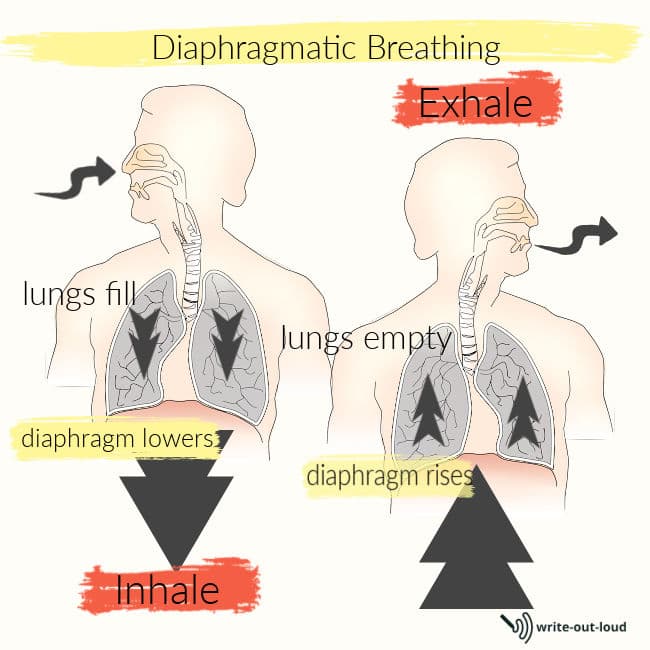
- Stand with your feet a comfortable shoulder width apart.
- Support the weight of your body through your hips and legs rather than locking your knees.
- Consciously release and relax your shoulders.
- If you're holding your stomach in, let it go.
- Place your hands on your stomach.
- Breathe in through your nose to the count of four. Count slowly. As you inhale feel your diaphragm rising.
- Breathe out through your mouth to the count of four and now feel your diaphragm expanding.
- Do three rounds of inhale and exhale to a four count while making sure you keep your shoulders, stomach and legs relaxed.
- Once you have mastered the four count, increase it. Through regular practice you will soon be able to extend it for an eight or even ten count.
Variations on this breathing exercise
1. Lie on the floor or sit in a chair.
(Either way, make sure your legs are uncrossed.)
2. Use the out-breath to hum quietly.
Increase the intensity and volume as you go through each rounds.
3. Use the out-breath to sound each of the vowel sounds in turn.
Let each go without force, flowing smoothly from your relaxed throat.
For example:
'A' is going to become ahhhhhhh... as in 'are'
'E' is Eeeeeeeeeeeee ... as in 'easy'
'I' is Iiiiiiii ...as in 'eye'
'O' is Ooooooo ...as in 'Oh'
'U' is Uuuuuuuu ...as in 'you'
Feel the shape of the sound in your mouth and enjoy its resonance.
4. Use imagery by adding color.
Imagine your in-breath as a light, energy intensive color washing through all the cells in your body from your toes to the top of your head.
Then imagine your out-breath as clearing away all the debris and dross.
5. Imagine the in-breath coming from deep within the earth.
Send it traveling through all your limbs and organs to the top of your head carrying its life giving and grounding forces with it.
6. Use imagery by adding pictures of yourself achieving all that you want to in your speech.
See yourself competent, smiling and confident. See the audience enjoying your talk.
Breathing in clarity and calm - exercise two
- Stand with your feet a comfortable shoulder width apart.
- Support the weight of your body through your hips and legs rather than locking your knees.
- Consciously release and relax your shoulders.
- If you're holding your stomach in, let it go.
- Bring your palms together in the center of your chest.
- As you slowly inhale through your nose, keeping the palms of your hands together, raise your arms as high as you can above your head. At the same time raise yourself on to your toes.
- Hold your breath briefly at the top of your inhale keeping yourself fully stretched and pushing without strain toward to the sky.
- Exhale slowly through your mouth and now bring your arms slowly down and round back up to your chest, with your palms together in the starting position.
- At the same time slowly lower your feet.
- Repeat for ten rounds.
You can use this exercise with counting as well. Eg. In-breath 1, 2, 3, 4 as the arms go up. Out-breath 1, 2, 3, 4 as they come down. It has the same positive effects as the first exercise with the addition of gentle full body stretching.
For variation, use any of the imagery or sounding suggestions from the first exercise.
It works. I can vouch for its effectiveness.
I've used this exercise with drama classes during rehearsal and prior to performances for years. It's made an enormous difference to the overall quality of work as it centers, concentrates and calms.
I also use it for myself whenever I catch myself getting tense. It takes very little time and can be shortened to a mere two rounds if needs be.
The benefits of breathing exercises
The benefits of both these breathing exercises for public speaking are immediate: psychologically and physically.
Physiologically you are using all of your lungs rather than the top third and have more oxygen in your system. You'll feel better, more able to cope, to think clearly.
An additional benefit is you are strengthening your physical capacity to speak for a longer time, to deal with more complex patterns of language effectively and you won't need to break for breath as frequently.
Help especially for children

If you've arrived here at looking for ways to help a child manage public speaking anxiety, teach them these breathing exercises.
They will understand, particularly if you show and do them with them. I know because I've done it. They are effective, even with very young ones.
And then please take a look at my page on 'how to build confidence in a child'.
You'll find suggestions and activities to enhance and foster self-esteem suitable for children from kindergarten to approximately 8-9 years old.
(They're able to be easily adapted for children outside those age ranges too.)
Although not a quick-fix, they will, with practice, over time really benefit your child.
Call in professional hypnotherapy help
For a gentle, effective treatment to help yourself shift and break the cycle of fear you experience around giving a speech, try self-hypnosis.
For more information on using hypnotherapy to manage public speaking anxiety
More resources
If you would like more than these breathing exercises to help either yourself, a child or a friend, please look at my page on acute anxiety help for public speakers or this one on dealing with public speaking nerves. You'll find many more positive suggestions there.
And click this verywellhealth.com link for 10 more breathing exercises to help with anxiety.
For more on the significant impact of the quality of your voice has on what happens in your life go to: Voice image secrets. What's the quality of your voice telling others?


